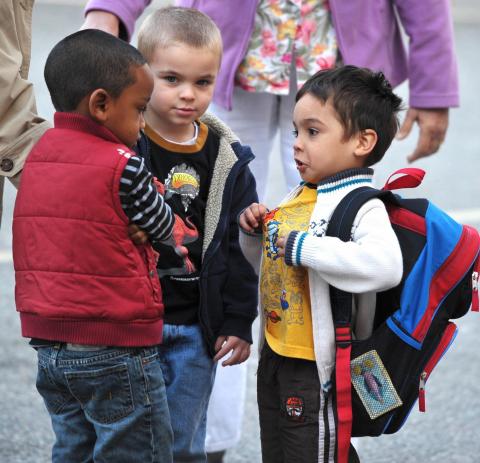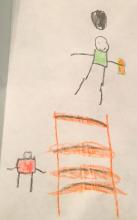Supporting Young Writers in the Home // Part 1 of 2

Long before any of my children were of school age, they were writers. Matthew, at two years old, would "fill out"the collection envelopes in Mass, making marks in the "name," "address" and "amount" blanks. Grace, now three, flits about the house taking orders on a Post-it pad before turning to her play kitchen to prepare meals for her imagined customers. When my husband travels for work, the kids beg for my phone before bedtime, pleading with me for permission to "text dad a message." Even the youngest ones will type a letter or two they recognize as part of their own names and then string together rows of emojis.
While each of us is always becoming a better writer, my children remind me again and again that each of us has always been a writer.
Children–even before school (and sometimes in spite of school)–are writers. Within the past several weeks, the National Council of Teachers of English (NCTE) published an updated statement titled "Parents as Partners in Promoting Writing among Children and Youth." NCTE's statement positions the home and family as playing a vital role in the cultivation of purposeful and skillful writers.
Research on children's writing practices underwent a theoretical shift in the 1980s, from what was previously a readiness perspective to an emergent literacy perspective. This shift has important implications for the role that activities in the home can play for children's development as writers. Whereas the readiness perspective considered the first signs of conventional letter encoding and spelling as the first indicators of writing, emergent-literacy researchers defined writing as any human interaction with print in which a writer believed he or she was making sense through written language. The more recent work of scholars like Deborah Wells Rowe takes seriously an even earlier phase of a writer's development. For Rowe, writing development can happen even outside of intentional acts of sense-making via written language. Children can learn and develop as writers as they participate with others in writing events and activities. This evolution in perspective on what constitutes writing suggests that the social environment of the home can serve as a rich site to support children's development as writers.
Below, we outline a few ways that family members might support children's writing development outside of school. On Thursday, we will outline even more strategies parents can use to develop their children into writers.
1) Encourage Talk and Storytelling

Talk and writing go hand-in-hand. Children develop voice, they cultivate ideas, and they discover concepts in and through talk. Talk in the context of play can be especially productive, given the space that play creates for the imagination. Both talk and play afford children the opportunity to make sense of the world, which is essentially the work that writing does. In addition, many of the rhetorical dimensions of writing–namely audience, purpose, and situation–are essential factors in both talk and in play.
When my five-year-old breaks out his bins of superhero toys and LEGO sets, entire worlds are born, conflicts erupt, and narrative arcs unfold. The play itself, and the dialogue that ensues between and among his superheroes, is a fertile ground for ideas. From there, my husband and my own questions to our son about his play–"What happened?" "Who won?" "What's going on over here?"–give him the opportunity to organize, to clarify, and to elaborate whatever schema he has devised–much like any writer would need to do to organize, clarify, and elaborate his ideas in whatever piece he is composing.
2) Expand Opportunities for Representation

The concept of writing, and especially our own experiences of writing in the context of school, might trigger a certain set of expectations: linear rows of words in neatly packaged sentences, proper spelling, grammatical correctness. Even drawing, though, can play a role in children's–especially young children's–writing development given its capacity to build fine motor skills needed for writing. Openness to drawing and to pictorial representation of ideas, particularly for children who have not yet been introduced to alphabetic print, allows young writers the experience of matching purpose with message. As children begin to develop in their knowledge and awareness of letter-sound correspondence, parents' and teachers' openness to invented spelling can increase children's writing fluency.
*For more tips, continue reading Part 2 of this fantastic blog post!
